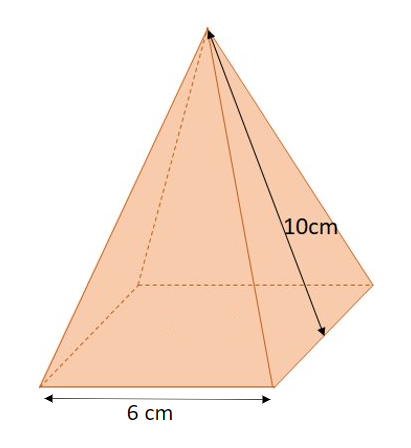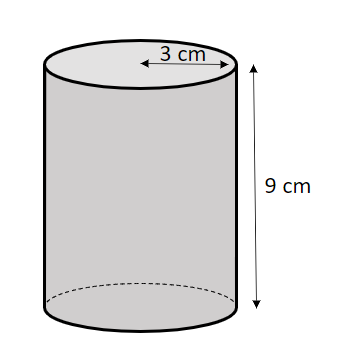Note:
Use Q1 and Q2 from Surface Area of 3D Shapes from GCSE.
Q3
The pyramid below is made up of a square base with side length of 6 cm and 4 identical triangles with height of 10 cm.
Work out the surface area of the pyramid.

Answer: 156 cm^2
Wrong Answers:
216 cm^2
254 cm^2
96 cm^2
WORKING:
Area of the square base of the pyramid = 6\times6 = 36 cm^2.
Area of each triangular base = \dfrac{1}{2}\times10\times6=30 cm^2.
Surface area of pyramid = 36+(30\times4)=156 cm^2.
Q4
Calculate the surface area of the cylinder below to 2 decimal places.
Use \pi=3.14.

Answer: 226.08 cm^2
Wrong Answers:
254.34 cm^2
110.52 cm^2
197.82 cm^2
WORKING:
Net of the cylinder:

We can work out the length of the rectangle by calculating the circumference of the circle.
Circumference = 3.14\times2\times3=18.84 cm.
Area of rectangle = 18.84\times9=169.56 cm^2.
Area of circle = 3.14\times3^2=28.26 cm^2.
Surface area of cylinder = 169.56+(28.26\times2)=226.08 cm^2.
Q5

Calculate the surface error of the shape shown above.
Answer: 396 cm^2
Wrong Answers:
380 cm^2
346 cm^2
426 cm^2
WORKING:
The combined surface area of the front and back facing sides:
2\times(7\times4+5\times2)=2\times(28+10)=76 cm^2.
Surface area of the bottom face:
9\times10=90 cm^2.
Surface area of sides facing upwards:
(4\times10)+[latex](5\times10)=40+50=90 cm^2.
Surface area of side facing left:
7\times10=70 cm^2.
Surface area of side facing right:
(2\times10)+(5\times10)=70 cm^2.
Total Surface area:
76+90+90+70+70=396 cm^2.
